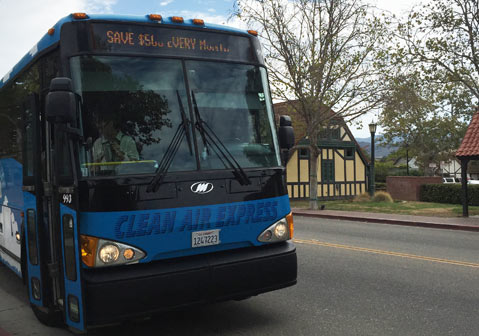New Saturday Service By Clean Air Express

From the bright blue sky framing downtown Santa Barbara emerged a beast of a brighter blue: The Clean Air Express, a clean diesel transit service now connecting Santa Barbara with major parts of northern Santa Barbara County.
Since 1991, The Clean Air Express has offered weekday services between Lompoc/Santa Maria and Goleta/Santa Barbara that run daily during prime morning and evening commute hours. The new Saturday service, however, offers an affordable, convenient means for Santa Barbara residents to make a more recreational day trip to the Santa Ynez Valley, with reciprocal services offered for valley residents on a similar timetable.
My boyfriend and I boarded at the bus’s final morning stop outside the downtown train station on a Saturday that just happened to be my 22nd birthday. One-way cash fare is seven dollars, and the ride does not disappoint. As we stepped from 65 percent humidity onto the bus steps, a wave of air-conditioned refreshment met us at the door. Plush seats line both sides of the charter-style bus with ample legroom to spare, and Wi-Fi is even available onboard.
Kent Epperson manages the traffic solutions division of the Santa Barbara County Association of Governments (SBCAG), which operates The Clean Air Express. According to Epperson, the county’s Air Pollution Control District (APCD) managed the commuter service for a decade before SBCAG took over and expanded its operations, with financial support from the state in the name of alternative transportation. (In 1998, APCD founded Santa Barbara Car Free, a cooperative project that supports the service.)
Under APCD, the buses ran on compressed natural gas (CNG), which SBCAG has recently replaced with clean diesel fuel. A study by the nonprofit Clean Air Task Force indicates that CNG reduces service costs by 14 percent annually compared to clean diesel. However, more recent research by the Environmental Defense Fund suggests that the methane in CNG could have a more damaging effect on climate change than diesel long term, with warming power 84 times that of carbon dioxide, though its atmospheric life is about an eighth as long, at 12 years. According to the U.S. Environmental Protection Agency, the most harmful pollutant in diesel fuel, black carbon, has an atmospheric life of just days to weeks but the solar absorption power to do a disproportionate amount of damage in that time. Most clean diesel engines reduced these emissions by up to 98 percent by 2012. A case study of the Port of Oakland by the California Air Resources Board demonstrated a 76 percent decrease in black carbon emissions over the four years after the state mandated diesel drivers to upgrade.
Saturday morning departures from the valley are limited to a stop at Anderson’s Pea Soup in Buellton and another at Solvang Park, both between 9 and 10 a.m. Four departures along State Street in Santa Barbara take place over the following hour. Once passengers reach the valley, they may ride the Santa Ynez Transit Service between towns for free, courtesy of a partnership with The Clean Air Express.
We decided to deboard at the first valley stop in Solvang before the bus continued on to Buellton and Los Olivos. Several women from the Solvang Tourism Bureau greeted us with gift bags full of guides, coupons, and promotion materials from local businesses, before sending us on our way. The Express has similar partnerships with the Buellton Visitors’ Bureau and tourism website Visit Santa Ynez Valley. SBCAG, the county, the Buellton Visitors Bureau, the Solvang Conference & Visitor Bureau, and Visit Santa Ynez help pay for the bus service.
Despite the sweltering 93-degree weather, our first stop was at Jule Hus, Solvang’s one-stop shop for Christmas novelties and decorations all year round. Of all the crafty wares, what most captured my interest was a collection of miniature carved wood buildings designed to stand-alone or hang on a tree. From mini fire departments to mini wineries, each stood distinct from the next in its intricate detail.
Once we’d had our fill of premature holiday cheer, we headed to the Lucky Dogg to redeem the two-for-one wine tasting coupon included in our bag of touristy goodies. While the white wines on the tasting menu, a viognier and chardonnay, were a bit sweet for my taste, they did offer a unique fruitiness that neutralized any potentially overpowering hints of oak. I favored the winery’s Syrahs, especially the “Brady’s Blend,” whose smooth, peppery flavor warms the mouth with its richness.
Our next destination became an easy choice when the Lucky Dogg tasting hostess handed us another two-for-one coupon for Casa Cassara, just two doors down. Whereas the Lucky Dogg had been sleekly decorated with a few funky accents, this tasting room had more of a classic feel, with wooden countertops, barrels draped in tablecloths, and burnt orange walls adorned with various still life or scenic paintings. Two wines were standouts here, both reds of different varieties. The winery’s Sangiovese is a lighter red with hints of barbecue seasoning, a welcome flavor to the summer palate. To conclude the tasting, our hostess served the winery’s tempranillo, a Spanish varietal, with strawberries dressed in chocolate balsamic vinegar to create a deliciously sweet and refreshing pairing.
We continued our wandering until the Express pick-up time at 4:20 p.m., enjoying our buzz and some cheese along the way. Once back on the bus, we were soon lulled to sleep by its steady motion, already drowsy from wine and sun exposure.
Word of advice for future passengers: set an alarm just in case. The scolding of a bus driver shooing you off at route’s end makes for a rather rude awakening.



